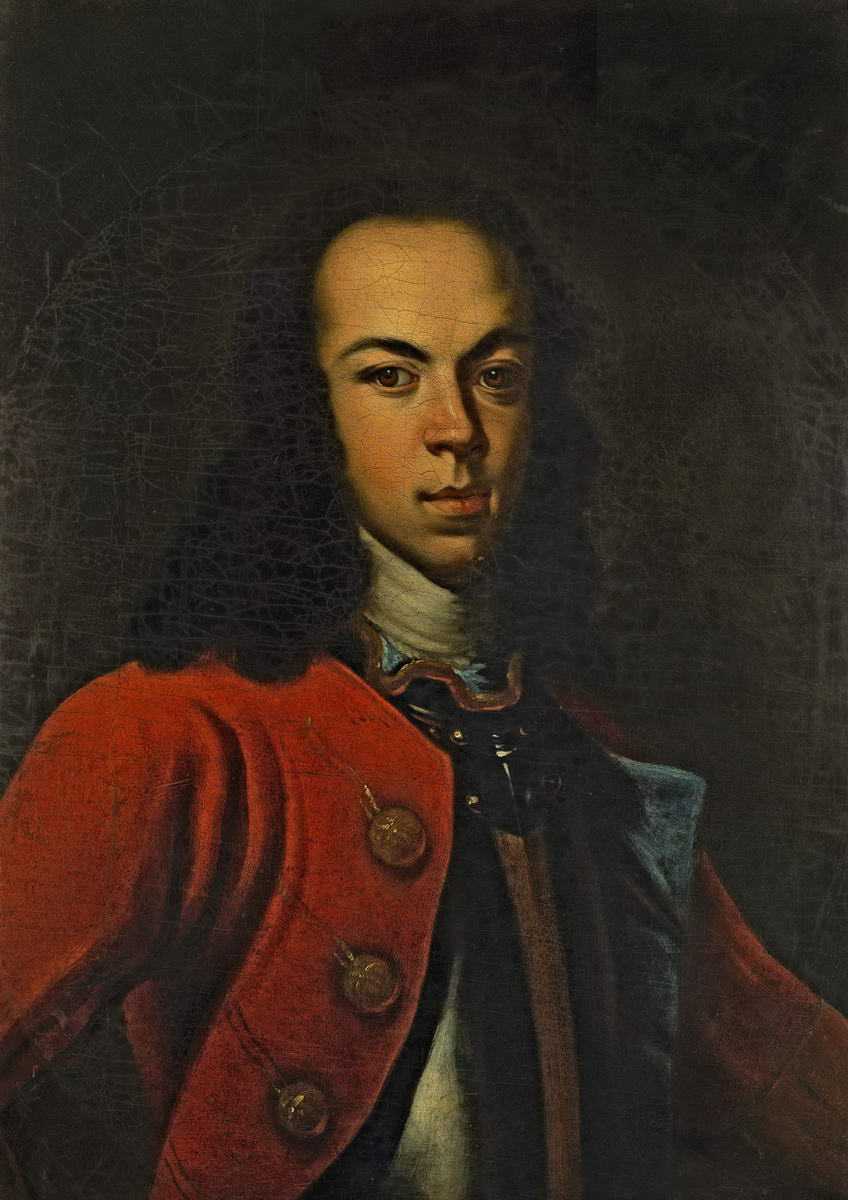


Царевич Алексей Петрович (1690–1718) – старший сын Петра I и Евдокии Федоровны Лопухиной. В качестве наследника престола неоднократно выполнял поручения отца в годы Северной войны. В 1709–1712 путешествовал по Европе, учился в Дрездене. В 1711 по настоянию отца женился на принцессе Шарлоте Христине Софии Брауншвейг-Вольфенбютельской, от брака с ней имел дочь Наталью и сына Петра (впоследствии императора Петра II). Находился в оппозиции к реформам Петра I. В конце 1716 года тайно уехал в Вену под защиту австрийского императора Карла VI. Жил в замке Эренбург (Тироль), с мая 1717 – в Неаполе. В январе 1718 года, поддавшись уговорам П. Толстого и А. Румянцева, вернулся в Россию. Был арестован и заключен в Петропавловскую крепость. После следствия приговорен Верховным судом к смертной казни. В конце июля 1718, через несколько дней после вынесения приговора, умер в Петропавловской крепости при невыясненных обстоятельствах.
Отсутствие на портрете ордена Св. Андрея Первозванного (получил в 1711 и лишен только в 1718 году) и возраст модели позволяют предположить датировку портрета периодом сватовства и знакомства с будущей женой (Шарлоттой Кристиной Софией, рожденной принцессой Брауншвейг-Вольфенбюттельской), которое состоялось весной 1710 года в Шлакенверте (Карловы Вары). Петр I. Время и окружение. СПб, 2015. С. 61.
Немецкий живописец, портретист, миниатюрист.
Первоначально занимался часовым делом и музыкой. Живописи учился в Венеции у С. Бомбелли. Затем жил в Голландии, копировал Рубенса. Будучи за границей, Петр I по рекомендации художника Я. Купецкого пригласил Таннауера в Россию. 1 октября 1710 в Вене был заключен контракт о его поступлении на русскую службу в качестве живописца. В марте 1711 приехал в Смоленск, сопровождал Петра I в Прутском походе, затем поселился в Петербурге. Был придворным живописцем. Писал портреты, исторические картины, миниатюры, делал рисунки тушью, ремонтировал часы. Сын Таннауера, Иоганн Себастьян, учился гравированию при Академии наук. Среди его учеников были Еропкин, Усов и Ф. Черкасов. Неоднократно писал портреты Петра I и Екатерины I. Одной из самых известных его картин является конный портрет Петра: “Петр I в Полтавской битве”, 1725 (4?), хранящийся в Русском музее.

Alexis Petrovich (February 18, 1690 – June 26, 1718). Tsarevich, eldest son of Peter the Great. He was considered to be the legitimate successor to the throne before being arrested in February 1718. As heir to the throne he fulfilled many of his father’s assignments during the Northern War period. During the years 1709–1712 he travelled across Europe and studied in Dresden. On October 14, 1711 Alexis married Princess Charlotte Christine Sophie of Brunswick-Wolfenbüttel, sister of Elizabeth Christine, who was married to Emperor Charles VI of Austria. Alexis had two children: Natalia (July 21, 1714 – November 22, 1728) and Peter (October 12, 1715 – January 19, 1730) – the future Emperor Peter II; who would rule after Catherine I. Alexis opposed the reforms of Peter the Great. In the end of 1716 he secretly left for Vienna and placed himself under the protection of Emperor Charles IV of Austria. He lived in the Ehrenburg castle (Tyrol), and starting from May 1717 – in Naples. In January 1718 he succumbed to persuasion of Pyotr Tolstoy and Alexander Rumyantsev and returned to Russia, where he was arrested and locked up in the Peter and Paul Fortress. He was then sentenced to death by the Supreme Court. In the end of July 1718 he died under unclear circumstances several days after being condemned.
The fact that the Order of St. Andrew the Apostle the First-Called is not included in the portrait (Alexis received it in 1711 and was only stripped of it in 1718) and the subject’s age allow us to suggest that the portrait was created when Alexis met his wife (Charlotte Christine Sophie, née Princess of Brunswick- Wolfenbüttel) and proposed to her in spring 1710 in Schlackenwerth (Karlovy Vary).
German painter, portrait artist, and miniaturist. Initially, Tannauer would practice watchmaking and music. He studied painting in Venice under S. Bombelli. Subsequently, he lived in Holland, where he would copy Rubens’s paintings. When Peter the Great was abroad, he invited Tannauer to come to Russia upon the recommendation of Johannes Kupezky. On October 1, 1710 an agreement was signed in Vienna, making Tannauer a painter serving in Russia. In March 1711 the artist came to Smolensk. During the Pruth River Campaign, he accompanied Peter the Great, and then settled down in St Petersburg. He was a court artist. Tannauer painted portraits, historical pictures, and miniatures; he also created ink drawings and fixed clocks. His son, Johann Sebastian Tannauer, studied engraving at the Academy of Sciences.



